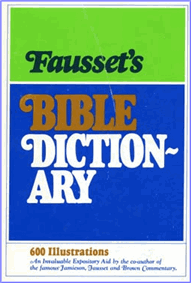Fausset's Bible Dictionary
A B C D E F G H I J K L M N O P Q R S T U V W X Y Z
Myrtle
Used (as it is still by the modern Jews) on the return from Babylon to adorn booths for the feast of tabernacles (Nehemiah 8:15). It then grew on the hills about Jerusalem and Olivet, where now there are only the olive and the fig tree. Hereafter about to grow in what was a wilderness (Isaiah 41:19; Isaiah 4:18). The myrtle in Zechariah 1:8; Zechariah 1:10-11, symbolizes the Jewish church, not a stately cedar but a lowly though fragrant myrtle. Its depression made the Jews despond; the Angel of Jehovah standing (as in His abiding place, Psalm 132:14) among the myrtles guarantees her safety, lowly though she be. The myrtle was probably imported into Israel from Babylon in the time of Isaiah who first mentions it. It is a native of Persia. Esther received her name Hadassah, "the myrtle," in the Persian court (Esther 2:7). In Samaria and Galilee on the banks of rivers it still abounds. Its starry blossoms amidst dark and odorous leaves, and flexible branches, furnish a beautiful garland, so that in Greece it was held sacred to Venus the goddess of beauty.
Bibliography Information
Fausset, Andrew Robert M.A., D.D., "Definition for 'myrtle' Fausset's Bible Dictionary".
bible-history.com - Fausset's; 1878.
Copyright Information
© Fausset's Bible Dictionary
Fausset's Bible Dictionary Home
Bible History Online Home
Bible Encyclopedia (ISBE)
Online Bible (KJV)
Naves Topical Bible
Smith's Bible Dictionary
Easton's Bible Dictionary
Schaff's Bible Dictionary
Fausset's Bible Dictionary
Matthew Henry Bible Commentary
Hitchcock's Bible Dictionary

Dr. A.R. Fausset
Popular and Trending:
Meaning and definition of fasting, what is fasting in the bible, fasting definition, why should I fast, the power of prayer and fasting, Location of Galilee, where was galilee in the bible?, fasting definition, Galilee region, cities of Galilee, Sea of Galilee, Definition of biblical fire, what is fire in the bible?, fire and brimstone, fire meaning, baking bread with fire, Definition of the biblical firmament in Genesis, what is the firmament in the bible?, was the firmament the third heaven, firmament meaning, did the firmament bring the flood of Noah?.
